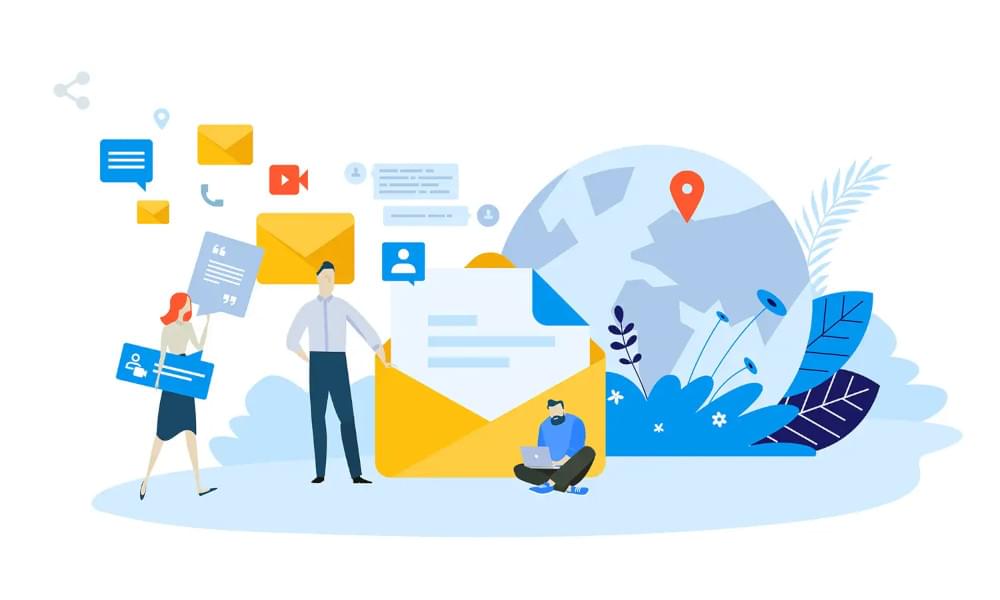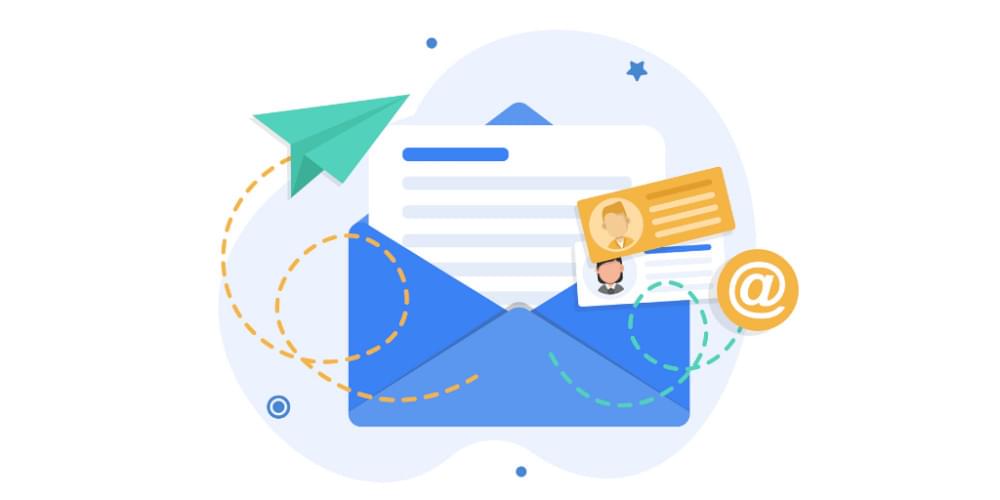Ahoy there, fellow marketers! It’s time to hoist the sails and navigate the stormy seas of professional email communication. So let’s batten down the hatches and chart a course toward effective email marketing! With a well-crafted format and a sprinkle of creativity, we can steer clear of the dreaded “spam” label and anchor ourselves in the waters of success.
With an email format, you can ensure your message is impressive, no matter the occasion. It’s like a virtual outfit for your message, helping it look put-together and presentable. Think of it as the difference between a well-dressed individual and a slob; the former is more likely to get noticed and taken seriously. So don’t be a slob, put some effort into your email format, and you’ll stand out in the inbox crowd.

It’s like building a sandwich, but you’ve got a subject line and a signature instead of bread and meat. You start with a solid foundation: the email address and salutation. Then you add some flavor with an introduction that sets the tone for the message. The email body is where the meat of your message goes, and you want to ensure it’s not too dry or too fatty. Finish it with a nice, crisp ending and a signature that ties it together. Just like a good sandwich, a well-formatted email is satisfying, easy to digest, and leaves you feeling full of professional prowess.
What is an Email Format?
You can tailor your message using a proper format of an email based on the recipient’s needs and preferences. An email’s format includes everything from the subject line to the email signature. The intent of emails is usually the same, regardless of format - to convey the intended message.
Keeping that in mind, let’s examine how different elements contribute to creating an effective email structure format.

What are the Components of a Professional Email Format?
As marketers, we know how we present ourselves through emails can make or break a business deal. Now let’s review the components of a professional email
Email Subject Line
When writing email subject lines, consider the recipient and the purpose of the message. A recipient will first notice the subject line. So, it is essential to clarify the purpose of sending a particular email. You can write a compelling subject line by following these steps:
- Don’t exceed the standard character limit
- keep it clear, concise, and to the point.
Email Address and Salutation
You address the recipient directly in the salutation of your email, usually by name. You can use only a few phrases in business letters, such as:
- Dear Mr. John:
- Dear John:
- To Whom It May Concern:
There are several acceptable salutation styles in the world of email, however. In a given situation, it depends on your relationship with the recipient, your company’s culture, and the message’s content.
A Single Recipient’s Email Salutations
The following are some of the most common salutations for a single recipient in email messages. The salutations are loosely organized from more formal to less formal.
- To Whom It May Concern
- Dear Sir or Madam
- Dear Mr. Andy:
- Dear Andy:
- Good morning, Lara.
- Hello, Smith.
- Hello Smith,
- Hi Smith,
The following are comments on group email messages with good and not-so-good salutations. Your company’s culture and context will determine whether these salutations are appropriate. Consider their composition before drafting your salutation when addressing a group of people.
Multiple Recipients’ Email Salutations
Use these salutations to address two or more people in a email.
- Greetings.
- Good morning.
- Good afternoon.
- Dear Sirs:
- Dear Gentlemen:
- Dear Colleagues:
- John and Smith,
- Dear John and Smith:
- Good morning, John and Smith.
- Hello,
- Hi, all!
- Hi!
- Guys,
However, it is essential to note that the appropriateness of either of these greetings will depend on the context and company culture.
Introduction
When you send an email introducing yourself, include a subject line, as it would be the first (and potentially the only) thing the recipient sees. If it isn’t compelling, recipient will ignore it.
The best way to introduce yourself to a client is to take a formal approach. We recommend always remaining professional in your introductory emails, despite the temptation to be informal. The subject line you choose for your introduction email needs to be clear or understood.
- What are the practical implications of this? Some email format examples are as follows:
- Introduction from
- Hello from
at - A quick hello
- Request to chat
- Looking for opportunities
You can use these subject lines as examples. If you want to update and personalize them, feel free to do so.
Email Body
Writers should push Enter twice after greeting the sender to ensure space between the greeting and the email body. In general, an email body follows the following format depending on the context:Ending
The closing of your email is what your recipient reads last. You can influence how quickly your audience responds by how you end your email and even motivate them to act. You can end your email in the following ways:“Sincerely,”
Professional closings like this one are favorites because they work in various situations. In this way, you let the recipient know you sincerely appreciate their time reading the email and following up on your requests.“Thank you for your time,”
Using this sign-off is another popular way to thank your audience for taking the time to read your email. When you acknowledge the reader’s attention, you can leave them with a positive impression of you. Professionals often have a variety of emails to read and respond to, so acknowledging it can go a long way in earning their trust.“Hope to talk soon,”
By closing this way, you reinforce the idea that you would like to continue the conversation or arrange a meeting. An excellent sign-off to include in cover letters, informational interview requests, and follow-up emails following interviews.
To conclude a professional email, here are some other options:
- Best,
- All the best,
- Regards,
- Thank you,
- Many thanks,
- Respectfully,
- Signature
You can convey your professionalism to your readers through an email signature and provide them with contact information. You leave a remarkable impression with an email signature, which helps make you stand out.
In today’s digital world, creating a professional image is vital. While crafting impeccable emails boosts professionalism, adding layers like a digital twist, such as QR codes, can elevate engagement. For instance, you can customize your QR Codes to reflect your brand identity and steer clients directly from email to specific web pages or promotional content.
Master these basic email components, and you’ll be on your way to crafting professional, effective emails that get results. Happy emailing!

The Importance of Professional Email for Business
Email marketing has become increasingly popular among businesses as it helps them attract prospects, retain existing customers, increase sales, and increase ROI. A continuous increase in the number of email users over the past six years has led to 4.2 billion active users by 2022.
Global email marketing spending expects to continue increasing in the coming years due to its cost-effectiveness and conversion-rich nature. It’s all possible with an effective email marketing strategy and campaign, which includes using the proper email format for your business.
You can stir interest in your products and services with a professional business email format, and you will also gain the following benefits:

- Provides regular updates to customers.
- Enhances trust.
- Strengthens relationships.
- Increases website traffic.
- It saves a lot of time.
- Communicates consistently.
- Provides constructive feedback.
- Produces a steady stream of leads.
- Ensures that customers keep coming back.
- Promotes brand awareness.
- Develops better relationships with vendors.
Email Users By Age
No signs of slowing down in email marketing. Statista reports that there are 4.26 billion email users. By 2025, the estimated number of email users worldwide will reach 4.6 billion.

A study of US email usage shows that the most frequent users are those between 25 and 44 years old. Almost 90.1% of people between 45 to 64 use email, followed by 90% of people between 15 and 24. 84.1% of internet users over the age of 65 also use email.

Basic Formatting Techniques
Your font style and size matter greatly to your reader when writing a professional email message. Make sure your font is clean, uncluttered, and easy to read.
You don’t have to use the default font in your email program. It is advisable to refrain from using novelty fonts, like those that look like bolded handwriting or cursive, as they can give the impression that your email could be more professional.
Font and Text Size
Even if your email is well-written, it will only be effective if it is easy to read. The best font choice depends on the size of your text and the font’s readable quality. Be sure your font size is large enough so the reader does not have to squint to read the email but not so large that they must scroll through the entire email. The font size should be between 10 to12, depending on the length of your text.
Email Font Styles
Make sure you stick to the classics. Use fonts like Arial, Verdana, Calibri, and Times New Roman for professional emails. Default email programs may use one of these styles. Alternatively, the program will offer them as an option.
Refrain from using fancy fonts like handwriting or script or any novelty fonts like Comic Sans. It may seem appealing to you, but it may be unprofessional, unreadable, or both to the recipient.
Be consistent with your font style and size throughout your messages, no matter what font style you choose. For readers, changing font types or sizes is jarring.
Text Alignment and Paragraph Spacing
Your email message will be easier to read if you use spaces properly. Your message should have lines after the greeting, between paragraphs, and before and after your signature. Readers can absorb text more easily with this white space. Breaking up long paragraphs with bullet points is another good way to introduce white space and make your email easier to read.
Text Color
Emails should include colors because they can convey meaning, trigger memories, and evoke emotions. Color increases brand recognition by 80 percent, according to research. 85% of shoppers buy products based on color.
Different colors can even evoke different emotions and associations. Consider how color communicates meaning in your daily life.
You should follow only two rules:
Don’t use too many colors
Colors should match your brand identity. Only use up to three colors in your email if you want your text to be readable. Use bold font to highlight a sentence or phrase. Different colors create ambiguity.Make use of contrasting colors
Contrast colors are ideal for bright colors. Black and dark gray are standard colors for email content. It’s easier to read. Exceptions include black backgrounds. Use white in this case. Avoid using light gray fonts on white backgrounds. To find the perfect contrasting color, you can use an easy color picker tool online.

Types of Email Format
There are several types of email formats, including professional, promotional emails, and transactional emails. Each type requires a different format and tone to be effective. The following are 7 types of email formats:
- Format for Professional Emails
A professional email uses a formal tone and is business related. For instance, a freelancer sending an email to a client during the onboarding process is a professional email. Personalized emails help bA professional email uses a formal tone and is business related. For instance, a freelancer sending an email to a client during the onboarding process is a professional email. Personalized emails help build relationships with recipients in today’s era.
To format a professional email, follow these steps:
- Personalize the subject line according to the recipient.
- Depending on your relationship with the recipient, use the proper greeting.
- You should introduce yourself and explain why you are writing the email. Make sure you connect with the person before you pitch your offer.
- Make sure the email ends with a clear call to action.
- Format for Welcome Emails
Engaging your subscribers with welcome emails is essential. Giving users a proper welcome email increases engagement and educates them about your company.
Boost engagement and build stronger connections by perfectly formatting your welcome emails:
- Make your subject line concise and distinct.
- Your email should begin with a proper greeting.
- Let your users know you appreciate their time and effort by thanking them.
- Explain what your brand is and what you offer.
- It is essential to have the right call to action in a welcome email. Users should know what action to take next.
- Salutations are important. It should be professional and friendly.
After thanking users and letting them know what to expect in future emails, this welcome email ends with a clear headline. Moreover, the email is to nurture leads and inform them.
- Format for Promotional Emails
A promotional email promotes a product, service, upcoming event, seasonal sale, etc., to increase sales. A well-formatted email is perfect for capturing people in a shopping mood. Additionally, segmenting email lists and targeting specific demographics or customer behaviors can further improve the effectiveness of sales prospecting in promotional emails.
The best way to format promotional emails is as follows:
- Cite the offer or personalize your subject line to make it appealing.
- Get started with a greeting. You can also use the first names of the users.
- Highlight your offer with a compelling headline. After that, you can explain how users can take advantage of the offer. To make it more engaging, you can embed GIFs and images.
- If applicable, add a QR code that directs users to a landing page with more information or the offer itself. You can easily generate a QR code using a reliable QR code generator.
- Keep email CTAs creative rather than generic in your promotional emails.
- Make sure to add your brand name, social media links, and relevant information.
- Format for Transactional Emails
Users receive transactional emails to update and inform them of their transactions. This can include order confirmations, shipping details, event registrations, etc. Moreover, these emails are important to keep users informed and do not usually contain a call to action. Transactional email issues can arise when users do not design a emails in a proper format, and they end up in spam or junk folders. So you should keep these things in mind while designing transactional emails.
Follow a standard format like;
- Greeting users by thanking them.
- Briefly describe the transaction, including the relevant attachment (link, invoice, etc. ), and thank them for checking their inbox.
- Using your brand name as a signoff.
- An email with a transactional format begins with greetings and then discloses the transaction details. Also, there is a call-to-action in the email.
- Format for Cold Emails
A cold email is one of the most challenging emails to send. Cold emails work wonders, even for strangers or someone you admire.
To do that, let’s look at these steps:
- Write a unique and intriguing subject line to make your cold email stand out.
- Keep your greetings professional, like Hi/Hello, Dear(name).
- Write a cold email after researching the recipient.
- Don’t pitch yourself in the beginning. Provide value by solving their problem.
- Build trust and authority by adding testimonials and references. Leave this part blank if you don’t have any.
- It is best to include another call to action on the email’s end to clarify it.
- Keep it professional with a signature like Regards, (Your name). It is also good to express your gratitude for the recipient’s time.
- Email Format for Newsletters
Newsletters have various purposes, including informational, call-to-action, and multiple call-to-actions. Besides to links to the latest blog posts, upcoming events, and job postings, Marketing Brew, Search Engine Journal sends out a weekly newsletter.
The format of a email newsletter is not predefined. Ideally, you should choose whatever resonates with your audience and helps you achieve your goals. However, some newsletters contain only the original post’s repurposed content and give you a preview.
- Let’s start with a generic headline and greeting. With the 1st CTA, we ask users for their opinions.
- Afterward, we include a list of the industry’s most relevant and trending topics.
- Our second CTA links to our latest growth chat. A GIF is also included to lighten the load of information.
- A third CTA appears at the end of the newsletter. It changes every time.
- We end with a feedback form to gain insights.
- Format for Follow-up Emails
Make it clear to the recipient follow-up emails should include a recap of earlier emails. You can email a user if they checked out your product pages but didn’t sign up, saying, “Feeling stuck somewhere? We can help.”
It begins by thanking users and greeting them by name. Next is the email copy and the feedback from CTA.

Use of Images and Graphics
Images and graphics can effectively add visual interest to an email and make it more engaging.
Inserting Images
It is important to optimize images for web use with appropriate file size and resolution.It is crucial to use high-quality images while optimizing them for web use with appropriate file size and resolution to ensure optimal display, including the option to unblur images for better clarity.Using Graphics for Emphasis
Graphics can highlight key information, such as promotions or calls to action.
Importance of Email Formatting in Business Communication
Business communication through email is fast, cheap, accessible, and easily replicable. Email is an efficient and effective way to transmit electronic data, which can greatly benefit businesses.
An email is a key form of business communication, and an email’s format can significantly impact its effectiveness. A professional email format enhances the sender’s image and makes the recipient more likely to read and respond to the message.

Best Practices for Professional Emails
Now that you understand why email communication best practices are so important let’s jump right into the practices you need to maximize your email communication – and reap the rewards in the process:
Avoiding Spam Filters
It is essential to avoid excessive use of certain words and phrases in emails to avoid triggering spam filters. Spam filters evaluate several factors when deciding whether an email should go into the primary inbox or the junk folder, including:- Suspicious or false subject lines
- Senders with blacklisted IP
- Spam phrases or words
- Rule-based input from recipients that eliminate spam
- Keeping Emails Brief and to the Point
Emails should be brief, with only essential information included. Your message could become messy and confusing if you stray from your main point. Be sure to remain focused and provide only pertinent information to encourage readers to respond to the call to action.
Proofreading Before Sending
Emails should be proofread for typos, grammar, and clarity before sending. Perfectly proofread emails don’t need grammar expertise. You can use tools like ProWriting Aid or Grammarly to proofread for you.Remember that while these tools are effective, there is still a possibility that an editing error could slip through. Be sure to review your email before sending it.
Conclusion
A professional email format is essential for effective business communication. By following best practices and using the proper format, marketers can improve the chances that the recipients not only read their emails but will respond to them and act upon them. With a little effort, marketers can make their emails professional, engaging, and effective.











